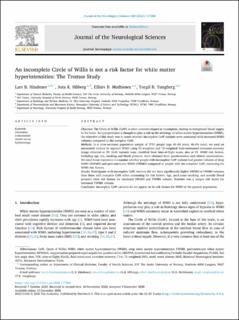| dc.contributor.author | Hindenes, Lars Bakke | |
| dc.contributor.author | Håberg, Asta Kristine | |
| dc.contributor.author | Mathiesen, Ellisiv B | |
| dc.contributor.author | Vangberg, Torgil Riise | |
| dc.date.accessioned | 2021-02-12T09:36:37Z | |
| dc.date.available | 2021-02-12T09:36:37Z | |
| dc.date.created | 2020-12-17T15:36:25Z | |
| dc.date.issued | 2020 | |
| dc.identifier.issn | 1302-1664 | |
| dc.identifier.uri | https://hdl.handle.net/11250/2727631 | |
| dc.description.abstract | Objective
The Circle of Willis (CoW) is often underdeveloped or incomplete, leading to suboptimal blood supply to the brain. As hypoperfusion is thought to play a role in the aetiology of white matter hyperintensities (WMH), the objective of this study was to assess whether incomplete CoW variants were associated with increased WMH volumes compared to the complete CoW.
Methods
In a cross-sectional population sample of 1751 people (age 40–84 years, 46.4% men), we used an automated method to segment WMH using T1-weighted and T2-weighted fluid-attenuated inversion recovery image obtained at 3T. CoW variants were classified from time-of-flight scans, also at 3T. WMH risk factors, including age, sex, smoking and blood pressure, were obtained from questionnaires and clinical examinations. We used linear regression to examine whether people with incomplete CoW variants had greater volumes of deep WMH (DWMH) and periventricular WMH (PWMH) compared to people with the complete CoW, correcting for WMH risk factors.
Results
Participants with incomplete CoW variants did not have significantly higher DWMH or PWMH volumes than those with complete CoW when accounting for risk factors. Age, pack-years smoking, and systolic blood pressure were risk factors for increased DWMH and PWMH volume. Diabetes was a unique risk factor for increased PWMH volume.
Conclusion
Incomplete CoW variants do not appear to be risk factors for WMH in the general population. | en_US |
| dc.language.iso | eng | en_US |
| dc.publisher | Elsevier | en_US |
| dc.rights | Navngivelse 4.0 Internasjonal | * |
| dc.rights.uri | http://creativecommons.org/licenses/by/4.0/deed.no | * |
| dc.title | An incomplete Circle of Willis is not a risk factor for white matter hyperintensities: The Tromsø Study | en_US |
| dc.type | Peer reviewed | en_US |
| dc.type | Journal article | en_US |
| dc.description.version | publishedVersion | en_US |
| dc.source.volume | 420 | en_US |
| dc.source.journal | Journal of Neurological Sciences | en_US |
| dc.source.issue | 117268 | en_US |
| dc.identifier.doi | 10.1016/j.jns.2020.117268 | |
| dc.identifier.cristin | 1861208 | |
| dc.relation.project | Helse Nord RHF: HNF1369-17 | en_US |
| dc.relation.project | Helse Nord RHF: SFP1271-16 | en_US |
| dc.relation.project | Notur/NorStore: NN9562K | en_US |
| dc.description.localcode | /© 2020 The Author(s). Published by Elsevier B.V. This is an open access article under the CC BY license (http://creativecommons.org/licenses/by/4.0/). | en_US |
| cristin.ispublished | true | |
| cristin.fulltext | original | |
| cristin.qualitycode | 1 | |

